CBSE Class 7 Maths Notes Chapter 5 Lines and Angles
A line segment has two endpoints and it is denoted by \(\bar { AB }\).
![]()
A ray has only one end point (its initial point) and it is denoted by \(\vec { AB }\).
![]()
A line has no end points on either side and it is denoted by \(\overleftrightarrow { AB }\).
![]()
If a single straight line passes through three or more points, the points are said to be collinear.
![]()
A, B, C are collinear points.
An angle is formed when two lines (or rays or line – segments) meet.

If the sum of measures of two angles is 90°, they are called complementary angles.
e.g. ∠A = 60°, ∠B = 30°
∠A + ∠B = 60° + 30° = 90°
If the sum of measures of two angles is 180°, they are called supplementary angles.
e.g. ∠A = 150°, ∠B = 30°
∠A + ∠B = 150° + 30° = 180°
If two angles have a common vertex and a common arm but no common interior, they are said to adjacent angles.
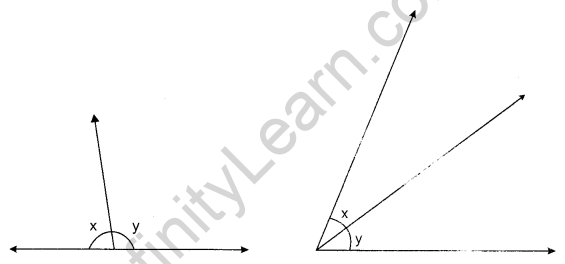
If two angles are adjacent and supplementary, they are said to be linear pair.
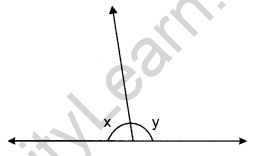
x + y = 180°.
When two lines meet at some point, they are said to be intersecting lines. The meeting point is called the point of intersection.

When two lines drawn on a sheet of paper do not meet, however far produced, they are said to be parallel lines.
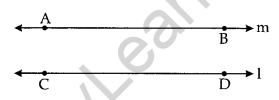
When two lines intersect, then the pair of opposite angles is said to vertically opposite angles. They are equal in measure.
A transversal line intersects two or more lines at distinct points.
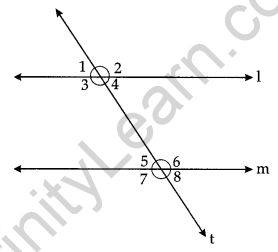
A transversal line gives rise to several types of angles.
| Types of Angles | Angles |
| Interior Angles | ∠3, ∠4, ∠5, ∠6 |
| Exterior Angles | ∠1, ∠2, ∠7, ∠8 |
| Corresponding Angles | ∠1 and ∠5, ∠2 and ∠6, ∠3 and ∠7, ∠4 and ∠8 |
| Alternate Interior Angles | ∠3 and ∠6, ∠4 and ∠5 |
| Alternate Exterior Angles | ∠1 and ∠8, ∠2 and ∠7 |
| The interior on the same side of the transversal | ∠3 and ∠5, ∠4 and ∠6 |
When a transversal cuts two parallel lines, then
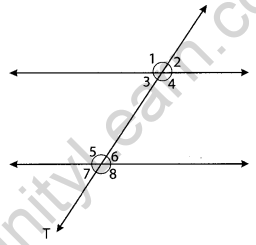
(a) Corresponding angles are equal.
∠1 = ∠5, ∠3 = ∠7, ∠2 = ∠6, ∠4 = ∠8
(b) Alternate interior angles are equal.
∠3 = ∠6, ∠4 = ∠5
(c) Interior angles on the same side of transversal are supplementary.
∠3 + ∠5 = 180°, ∠4 + ∠6 = 180°.
When the measure of the angle is less than 90°, it is said to be an acute angle.
When the measure of the angle is equal to 90°, it is said to the right angle.
When the measure of the angle is greater than 90°, it is said to the obtuse angle.
When the measure of the angle is greater than 180°, it is said to be the reflex angle.
A line segment has two endpoints.
A ray has only one endpoint (its vertex).
A line has no endpoints on either side.
An angle is formed when two lines (or rays or line-segments) meet.
Complementary Angles
When the sum of the measures of two angles is 90°, the angles are called complementary angles.
Supplementary Angles
When the sum of the measures of two angles is 180°, the angles are called supplementary angles.
Adjacent Angles
A pair of angles which are placed next to each other in such a way that they have a common vertex and an arm which is common to both the angles are called adjacent angles.
Linear Pair
A linear pair is a pair of adjacent angles whose non-common arms are opposite rays.
A pair of angles placed adjacent to each other is called a linear pair if the sum of their measures is 180°.
Note: A pair of supplementary angles form a linear pair when placed adjacent to each other.
When two lines intersect, the vertically opposite angles so formed are equal.

∠1 + ∠2 = 180° …(1)
∵ ∠1 and ∠2 form a linear pair
∠3 + ∠2 = 180° …(2)
∵ ∠3 and ∠2 form a linear pair
From (1) and (2)
∠1 = ∠3
Similarly, we can prove that ∠2 = ∠4
Intersecting Lines
Two lines intersect if they have a point in common called their point of intersection.
Transversal
A line that intersects two or more lines at different points is called a transversal.
Transversal of Parallel Lines
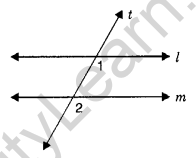
The lines on a plane that do not meet anywhere are called parallel lines.
Transversal of parallel lines give rise to quite interesting results.
We hope the given CBSE Class 7 Maths Notes Chapter 5 Lines and Angles Pdf free download will help you. If you have any query regarding NCERT Class 7 Maths Notes Chapter 5 Lines and Angles, drop a comment below and we will get back to you at the earliest.

